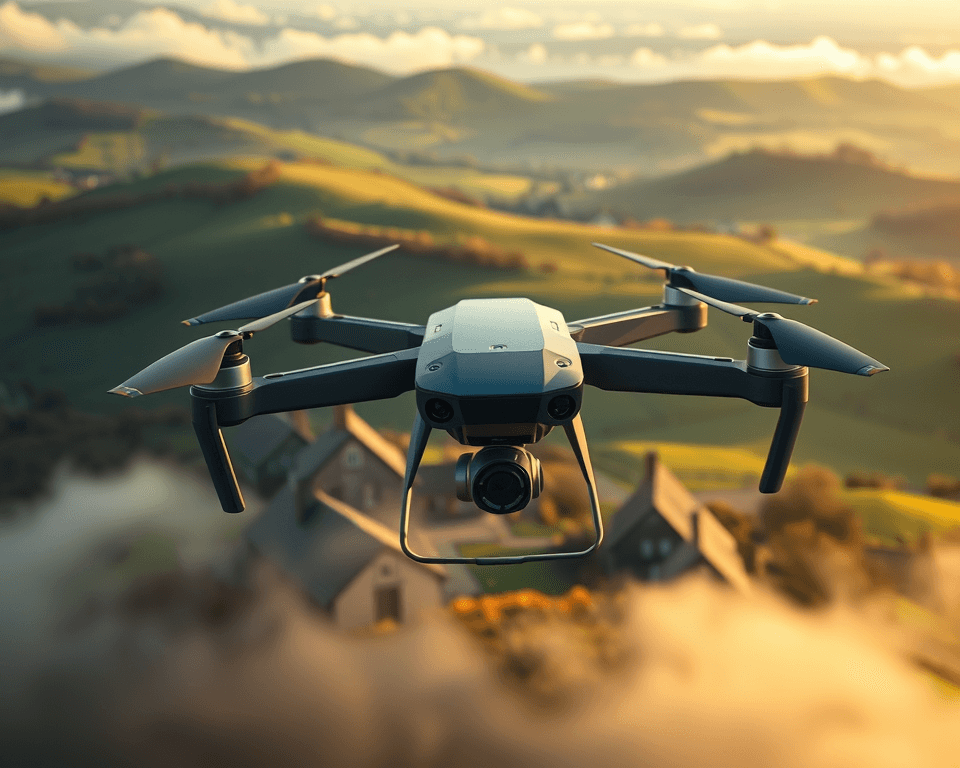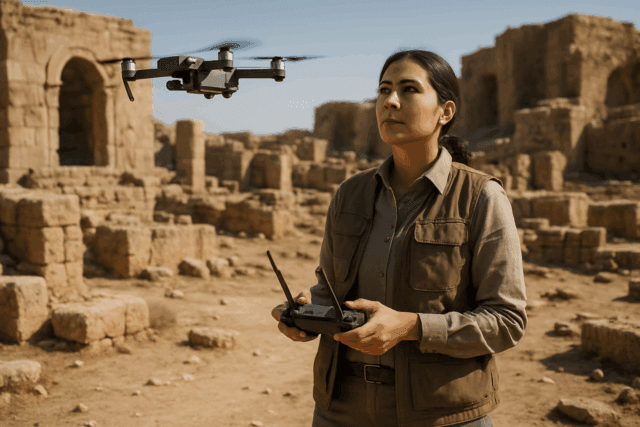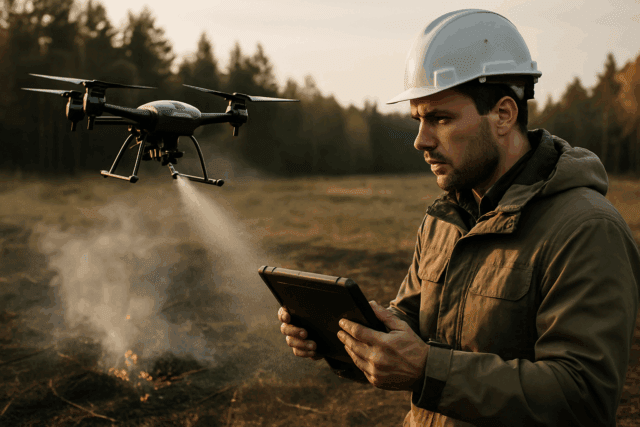Drones have moved from futuristic fantasy to everyday reality. Whether you’re interested in aerial photography, surveying land, or simply experiencing the thrill of flight, this guide will provide you with a solid foundation in drone technology. From understanding different types of drones and their components to navigating UK drone laws and mastering basic flight techniques, this comprehensive guide will help you take to the skies safely and confidently.
What Exactly is a Drone?
A drone, also known as an Unmanned Aerial Vehicle (UAV) or Remotely Piloted Aircraft (RPA), is an aircraft without a human pilot on board. Drones are controlled remotely by a pilot on the ground or autonomously through pre-programmed flight plans. They come in various shapes and sizes, each designed for specific purposes. From delivering packages to capturing breathtaking aerial footage, drones have become indispensable tools in various fields such as agriculture, construction, filmmaking, and surveying.
Types of Drones
Drones come in various shapes and sizes, each designed for specific purposes. Understanding the different types of drones is the first step in choosing the right one for your needs. Here’s an overview of the main categories:
Multi-Rotor Drones
Multi-rotor drones are the most common type, known for their ease of use and maneuverability. They use multiple rotors to generate lift and control.
Quadcopter: With four rotors, quadcopters are popular due to their stability and simple design. They’re great for aerial photography and recreational flying.
Hexacopter: Featuring six rotors, hexacopters offer increased stability and can carry heavier payloads. They are often used in professional filmmaking and industrial inspections.
Octocopter: Octocopters have eight rotors, providing maximum stability and redundancy. They are suitable for demanding applications such as carrying high-end cameras and sensors.
Advantages:
- Vertical Take-Off and Landing (VTOL)
- Easy to control and maneuver
- Relatively inexpensive
Disadvantages:
- Shorter flight times compared to fixed-wing drones
- Less efficient in windy conditions
Fixed-Wing Drones
Fixed-wing drones resemble traditional airplanes, using wings to generate lift. They are more efficient for long-distance flights and covering large areas.
**Advantages:**
* Longer flight times
* Higher speeds
* Ideal for surveying and mapping large areas
**Disadvantages:**
* Require a runway or launching system for takeoff and landing
* Less maneuverable than multi-rotor drones
* Not suitable for confined spaces
Single-Rotor Drones
Single-rotor drones resemble helicopters and are known for their efficiency and ability to carry heavy loads.
**Advantages:**
* Longer flight times compared to multi-rotor drones
* Capable of carrying heavier payloads
**Disadvantages:**
* More complex and expensive than multi-rotor drones
* Require more skill to operate
Hybrid VTOL Drones
Hybrid Vertical Take-Off and Landing (VTOL) drones combine the features of fixed-wing and multi-rotor designs. They can take off and land vertically but transition to fixed-wing flight for efficient long-distance travel.
**Advantages:**
* Combines VTOL capability with efficient fixed-wing flight
* Versatile for various applications
**Disadvantages:**
* More complex and expensive than other types
* Require sophisticated control systems
Other Drone Types
- Small Drones: Used for recreational purposes.
- Micro Drones: Small, provide valuable intelligence due to their micro cameras.
- Tactical Drones: Large without being bulky.
- Reconnaissance Drones: Measure approximately 16 feet in length, and can hover for long periods.
- Large Combat Drones.
- Non-Combat Large Drones.
- Target and Decoy Drones.
- GPS Drones.
- Photography Drones.
Essential Drone Components
Understanding the key components of a drone will help you maintain it properly and troubleshoot any issues that may arise. Here’s a breakdown of the main parts:
- Frame: The main structure that houses all the components.
- Motors: Power the propellers to generate lift and thrust.
- Propellers: Airfoils that create lift when spun by the motors.
- Electronic Speed Controllers (ESCs): Control the speed of the motors.
- Flight Controller: The “brains” of the drone, processing data from various sensors and controlling the motors to maintain stable flight.
- Battery: Provides power to the drone’s components.
- Receiver: Receives signals from the remote controller.
- GPS Module: Enables autonomous flight and return-to-home functionality.
- Camera: Captures aerial photos and videos.
- Gimbal: Stabilizes the camera for smooth footage.
- Sensors: Drones use a variety of sensors, including:
- Barometer: Measures altitude.
- Accelerometer: Measures acceleration.
- Gyroscope: Measures rotational rates.
- Magnetometer: Measures magnetic fields for orientation.
- Obstacle Avoidance Sensors: Detect obstacles in the drone’s path.
Getting Started: Choosing Your First Drone
Selecting the right drone as a beginner can be overwhelming. Here are some factors to consider:
- Budget: Entry-level drones can range from £50 to £300. Mid-range models with more features can cost between £300 and £1,000.
- Ease of Use: Look for drones with beginner-friendly features such as:
- GPS-assisted flight: Provides stable hovering and automatic return-to-home.
- Altitude Hold: Maintains a consistent altitude, making it easier to control.
- One-Key Takeoff/Landing: Simplifies the launching and landing process.
- Beginner Mode: Limits speed and altitude for safer flying.
- Camera Quality: If you’re interested in aerial photography, consider a drone with a built-in camera. Many beginner drones offer 4K video recording capabilities.
- Flight Time: Most beginner drones offer flight times between 10 and 30 minutes. Consider purchasing extra batteries to extend your flight sessions.
- Durability: Choose a drone made from durable materials that can withstand minor crashes and bumps.
Recommended Beginner Drones
- DJI Mini 4K: The best all-round drone for most beginners. A small, lightweight option that’s easy to fly and shoots sharp 4K video.
- Ryze Tello: The best budget beginner drone. An affordable flyer with a tiny design, the Ryze Tello is a top choice for beginners who want a cheap drone for learning the basics.
- DJI Mini 4 Pro: The best premium beginner drone, with incredible flight and safety features.
- DJI Neo: A super inexpensive drone that does FPV and also does some of the tracking modes, photos, and all of that.
UK Drone Laws and Regulations in 2025
It’s crucial to understand and comply with UK drone laws to ensure safe and legal flying. Here’s an overview of the key regulations:
Registration and Operator ID
- Drones with a camera (unless a toy) or weighing 250g or more must be registered with the Civil Aviation Authority (CAA).
- You must obtain an operator ID and display it on your drone. The operator ID must be visible from the outside of the aircraft, or within a compartment that can easily be accessed without using a tool.
Flying Restrictions
- Maximum Flight Altitude: Drones must not exceed 400 feet (120 meters) above the surface.
- Visual Line of Sight (VLOS): Operators must maintain a clear line of sight with the drone at all times, without using binoculars or other aids. Flying only during the day, avoiding flying through cloud, fog or smoke and not flying behind obstacles that stop you from always seeing your drone.
- Restricted Airspace: Permission is required before flying in restricted airspace (e.g., near government buildings, military bases).
- Airport No-Fly Zone: No flying within a 5-kilometer (3-mile) radius of airports.
Distance from People and Property
- Drones weighing 250g or more must remain 150 meters away from residential, commercial, or industrial zones.
- You must not fly your drone closer than 30 m to people — other than those helping to control or navigate your drone.
- You must not fly your drone over or above people at any time or height — a crowded beach, busy road, sporting event, concert or wedding are all populous areas.
Operational Categories
- A1 (Flying Over People): Allowed for drones under 250g.
- A2 (Flying Close to People): Requires a C2 drone and an A2 Certificate of Competency.
- A3 (Flying Far from People): For drones up to 25kg, only in remote areas.
Additional Regulations
- Only fly one drone at a time.
- Do not fly in a way that creates a hazard to another person, property or aircraft.
- Do not fly near emergency operations.
- Drones must be labelled with the operator ID.
Penalties
- Flying an unregistered drone can result in fines up to £1,000.
- Violating distance restrictions from built-up areas can lead to fines up to £3,000.
Upcoming Changes
- The CAA is reviewing UAS regulations to make them more UK-centric.
- Transitional benefits and policies may end, potentially restricting airspace access.
- A new class marking system for drones may be introduced.
Pre-Flight Checklist
Before each flight, it’s essential to perform a pre-flight check to ensure your drone is in good working condition and that you’re flying safely. Here’s a comprehensive checklist:
- Check Weather Conditions:
- Avoid flying in high winds, rain, or snow.
- Check the wind speed and direction.
- Ensure there is no chance of precipitation less than 10%.
- Inspect Drone:
- Check for any physical damage to the frame, propellers, and other components.
- Ensure the propellers are securely attached and in good condition.
- Check that there are no damages on the propellers and on the outside of the drone.
- Calibrate Compass:
- Calibrate your drone’s compass according to the manufacturer’s instructions.
- Follow the steps on the drone controller.
- Check Batteries:
- Make sure drone batteries and remote control batteries are fully charged.
- Ensure the batteries are properly installed and secured.
- Update Firmware:
- Ensure that the aircraft and battery have the latest firmware.
- Check it in the DJI Pilot application.
- Airspace Research:
- Conduct Airspace Classification Review.
- Verify that you are not flying in restricted airspace or near airports.
- Visual Inspection:
- Registration number is displayed properly and is legible.
- Remove Gimbal Cover:
- Remove the gimbal cover from the camera.
- Power Up:
- Turn on the remote control and open up DJI Go 4 app.
- Familiarize Yourself with Controls:
- Spend time understanding your drone’s capabilities and limitations.
- Familiarize yourself with the controls, flight modes, and emergency procedures.
Basic Flight Techniques
Mastering the basic flight controls is essential for safe and enjoyable drone flying. Here’s a breakdown of the key controls and techniques:
- Throttle (Up/Down): Controls the altitude, allowing you to make the drone ascend or descend.
- Yaw (Rotation): Rotates the drone left or right.
- Pitch (Forward/Backward): Moves the drone forward or backward by tilting it.
- Roll (Side to Side): Tilts the drone to move it left or right.
Step-by-Step Guide to Your First Flight
- Find an Open Space: Start in a wide, open area free from obstacles like trees, buildings, or people. An empty field is ideal for practicing.
- Check the Weather: Avoid flying in high winds or rain. Calm weather makes flying easier and safer, especially for beginners.
- Power Up and Pair the Drone: Turn on your drone and controller, then follow the manufacturer’s instructions to pair the devices.
- Hovering Practice: Start by simply getting your drone to hover in place. This helps you get used to controlling the altitude and stabilizing the drone.
- Learn to Rotate: Practice rotating (yaw) the drone left and right while maintaining its position. This helps improve control when changing directions.
- Practice Basic Movements: Once you’re comfortable hovering, practice moving your drone forward and backward (pitch) and side to side (roll). Try to keep your movements slow and controlled.
- Take Off and Land Safely: One of the most important skills is learning to take off smoothly and land gently.
Essential Safety Tips
Safety should always be your top priority when flying drones. Here are some essential tips to keep in mind:
- Maintain Visual Line of Sight: Always keep your drone within your line of sight. If you can’t see your drone, you’re flying blind.
- Respect Privacy: Be mindful of others’ privacy when flying your drone. Avoid flying over private properties, and never capture photos or videos of people without their consent.
- Avoid Crowded Areas: Flying over crowds or heavily populated areas increases the risk of accidents and invasions of privacy.
- Stay Below Maximum Altitude: Adhere to the altitude limits set by local aviation authorities to avoid interference with manned aircraft and ensure airspace safety.
- No Fly-Zones: Familiarize yourself with no-fly zones in your area, which often include airports, military bases, and national parks.
- Don’t Fly Near Other Aircraft: This is particularly crucial near airports. Give way to all manned aircraft.
- Be Sober and Alert: Never operate a drone while under the influence of alcohol or drugs.
- Take a Safety Course: Enrolling in a drone safety course can greatly enhance your flying skills and knowledge of regulations.
- Keep your drone within sight: If you can’t see your drone, you’re flying blind, and that’s a big no-no.
- Be Prepared for Emergencies.
Drone Maintenance
Proper maintenance is crucial for keeping your drone in top condition and extending its lifespan. Here are some essential maintenance tips:
- Regular Cleaning:
- Clean your drone regularly before flying.
- Use a soft brush to clear dust from motors and vents.
- Wipe down the structure of your drone with a clean, soft, and damp towel to clean it.
- Clean the motor after you finish flying remove the propellers and properly clean dust and debris in or on the motor.
- Lens cleaning – Use a lens pen or alcohol wipe (never paper towels).
- Propeller Care:
- Replace the propellers regularly, even if there is no visible damage, to ensure smooth operation of the drone.
- Do not hesitate to replace the propellers when there are cracks, deformations or any other signs of damage, however small
- When replacing the propellers, be sure to install them correctly, following the manufacturer’s instructions.
- Remember that it is not advisable to store drones with their propellers, to avoid bending or damaging them in the case of quick-mount propellers.
- Battery Maintenance:
- Good battery performance depends on how the battery is stored, so it is recommended to store it in a cool, dry place (22 to 28°C).
- In the case of drones such as DJI’s, it is recommended to fully cycle the battery every 20 flights, letting it discharge to around 8% and charging it once it has cooled down.
- Do not charge your battery for more than 2 days.
- Do not completely drain the batteries.
- Do not use damaged batteries for drones.
- Handle the batteries with great care.
- Store at 30-60% charge if unused for >1 week.
- Avoid extreme temps – Never leave batteries in hot cars or freezing conditions.
- Cycle monthly – Drain to 20%, then recharge to 80% to preserve health.
- Firmware Updates:
- Keep your drone’s firmware up to date is crucial for enhanced performance and access to new features.
- Motor Care:
- It is a very important step to keep the drone motor neat and clean.
- Proper cleaning of the motor prevents the drone to overheat.
- Storage:
- Make sure that you have a proper you have hard box or proper backpack to store the drone.
- Store the drone in a proper hard box or backpack and remove the batteries from the drone before storing it in the box.
- Use silica gel packs in your case to absorb moisture.
Exploring Drone Applications
Once you’ve mastered the basics, you can explore the various applications of drone technology:
- Aerial Photography and Videography: Capture stunning aerial footage for personal or professional use.
- Inspections: Inspect infrastructure such as bridges, power lines, and buildings.
- Delivery Services: Deliver packages, medicine, and other goods.
- Agriculture: Monitor crops, assess plant health, and optimize irrigation.
- Search and Rescue: Locate missing persons and assess disaster areas.
- Surveying and Mapping: Create accurate 3D models and maps of terrain and structures.
Final Thoughts
Drone technology offers exciting opportunities for both recreational and professional use. By understanding the basics of drone operation, complying with regulations, and practicing safe flying habits, you can enjoy the benefits of this innovative technology while minimizing risks. As you gain experience, you can explore the many applications of drones and unlock new possibilities in the skies.





